When a U.S. President dies, the usual waiting period is waived and a commemorative stamp in his (or someday her) honor is issued on that person’s next birthday. John  Hotchner looks at the history of this practice.
Hotchner looks at the history of this practice.
This is a tradition that has its roots in the 19th Century, with the issuance of the first presidential mourning stamp of the United States in April 1866, a 15¢ stamp in black (Scott #77, plus later grilled issues) honoring Abraham Lincoln, who had been assassinated a year earlier. The earliest known use, per Scott, is April 21, 1866.
A mourning stamp was a novelty in 1866, though earlier presidents had been included in the stamp program after their passing. But Lincoln set a new standard: a 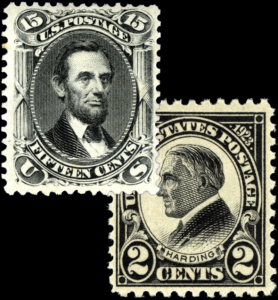 stamp in black, issued within a year of death, or shortly after.
stamp in black, issued within a year of death, or shortly after.
We would not see such an issuance again until the passing of Warren Harding from a heart attack on August 2, 1923. A mourning stamp in his honor – a flat plate-printed, perf. 11 version (Scott #610) – was released just a month later, on Sept.1, 1923. It was followed by three more versions (perf. 10 flat plate, imperf., and perf. 11 rotary press; Scott #s 611-613) within a couple of months.
After this there was a hit-or-miss period. Woodrow Wilson, who passed away in 1924, after he left office, was given a 17¢ memorial stamp in black almost two years after he died. William Howard Taft whose presidency ended in 1913, left us on March 8, 1930, and was included in the Fourth Bureau issue with a brown 4¢ sheet stamp and a coil just three months later.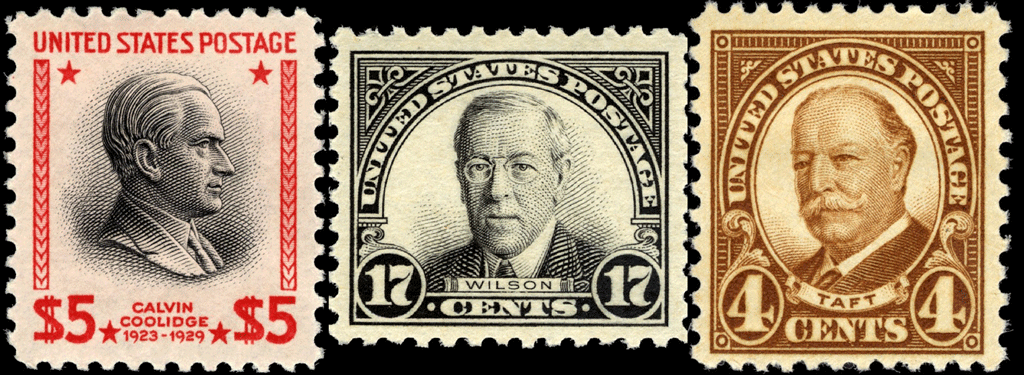
But Calvin Coolidge, who passed in 1933 was not placed on a stamp until the presidential issue of 1938, where he was the honoree on the $5 (Scott #834).
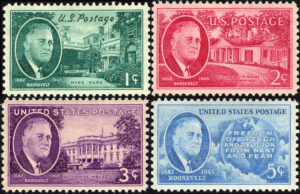 The next president to die was Franklin D. Roosevelt, on April 12, 1945; at the start of his fourth term. Four stamps were issued in his honor – none of them black – within a year of his death. The first was released on June 27, 1945; a 3¢ purple (which can be considered as a mourning color). It was followed by a 1¢ blue green, a 2¢ carmine rose, and a 5¢ bright blue (Scott #930-933). They broke the mold by including illustrations of more than just the picture of the president. See Figure 3.
The next president to die was Franklin D. Roosevelt, on April 12, 1945; at the start of his fourth term. Four stamps were issued in his honor – none of them black – within a year of his death. The first was released on June 27, 1945; a 3¢ purple (which can be considered as a mourning color). It was followed by a 1¢ blue green, a 2¢ carmine rose, and a 5¢ bright blue (Scott #930-933). They broke the mold by including illustrations of more than just the picture of the president. See Figure 3.
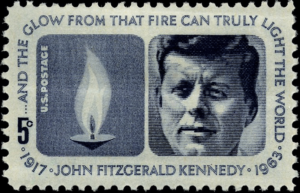 The next president to die was John F. Kennedy, the victim of an assassin, on November 22, 1963. And here is where the modern system of memorial stamps was inaugurated. On May 29, 1964, a 5¢ blue-grey commemorative was issued showing JFK and his eternal flame (Scott #1246). His birth date was May 29, 1917.
The next president to die was John F. Kennedy, the victim of an assassin, on November 22, 1963. And here is where the modern system of memorial stamps was inaugurated. On May 29, 1964, a 5¢ blue-grey commemorative was issued showing JFK and his eternal flame (Scott #1246). His birth date was May 29, 1917.
Presidential deaths after Kennedy, and the date of their memorial stamp (on or near their birthday), are shown here:
| President Herbert Hoover Dwight D. Eisenhower Harry S Truman Lyndon B. Johnson Richard Nixon Ronald Reagan Gerald Ford George H.W. Bush |
Date of Death Oct. 20, 1964 March 28, 1969 Dec. 26, 1972 Jan. 22, 1973 April 22, 1994 June 5, 2004 Dec. 26, 2006 Nov. 30, 2018 |
Stamp Issued Aug.10, 1965 Oct. 14, 1969 May 8, 1973 Aug. 27, 1973 April 26, 1995 Feb. 9, 2005 Aug. 31, 2007 June 12, 2019 |
We are long past the times when the U.S. Postal Service was simply reactive to a presidential passing. Wouldn’t be prudent. They now have “in the bank” an approved  image of each president who has left office, ready for use on the memorial stamp. It has been selected by the president himself and discussed with the immediate family as well.
image of each president who has left office, ready for use on the memorial stamp. It has been selected by the president himself and discussed with the immediate family as well.
Also gone are the grim black stamps that celebrate death, in favor of brighter colorful portraits. This is not to say that all the presidential memorial stamps are beautiful – or popular. Richard Nixon’s stamp was not expected to do well, so the USPS ordered only 80 million printed. Compare that to the 511,750,000 stamps ordered for JFK, and 170 million for Ronald Reagan.
[The USPS, however, has cut back on the number of stamps produced for all its issues. The initial print run for George H.W. Bush was 40 million, still significantly more than the production of other single-stamp issues in 2019.]
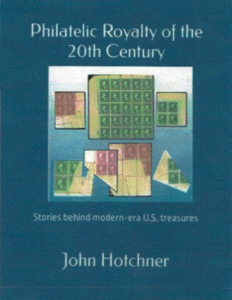 Should you wish to comment on this column, or have questions or ideas you would like to have explored in a future column, please write to John Hotchner, VSC Contributor, P.O. Box 1125, Falls Church, VA 22041-0125, or email, putting “VSC” in the subject line.
Should you wish to comment on this column, or have questions or ideas you would like to have explored in a future column, please write to John Hotchner, VSC Contributor, P.O. Box 1125, Falls Church, VA 22041-0125, or email, putting “VSC” in the subject line.
Or comment right here.
And John has a new book: Philatelic Royalty of the 20th Century: Stories behind modern-era U.S. Treasures. Order direct from the author; click here for details.



